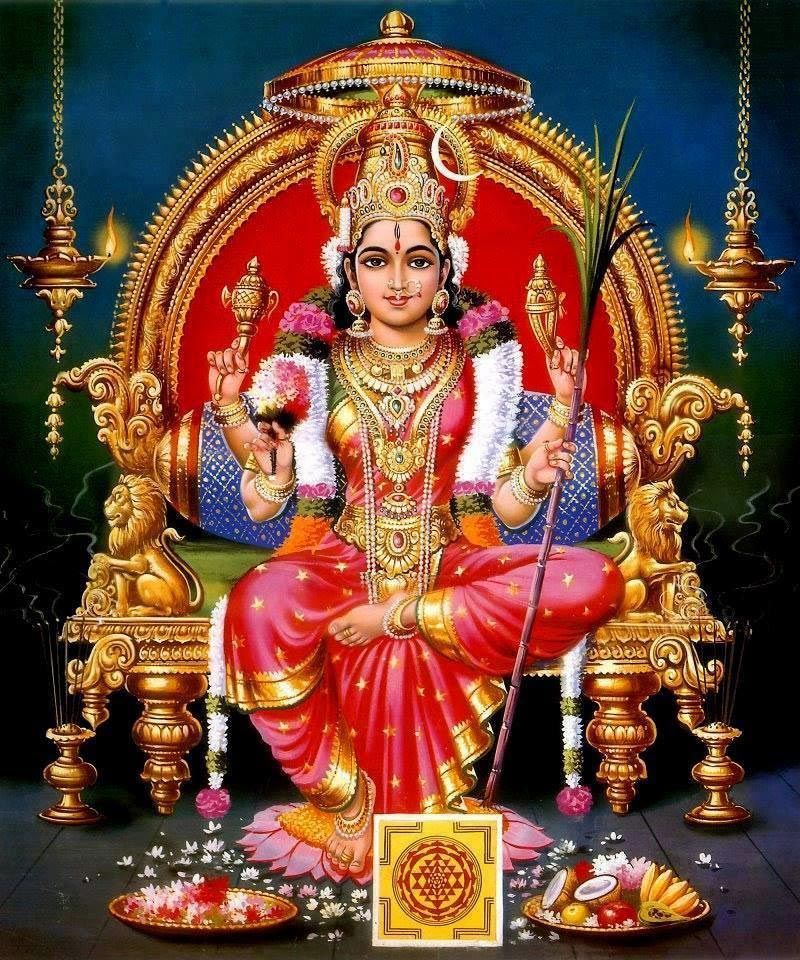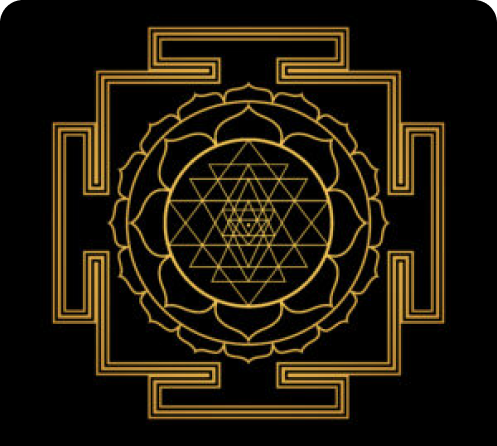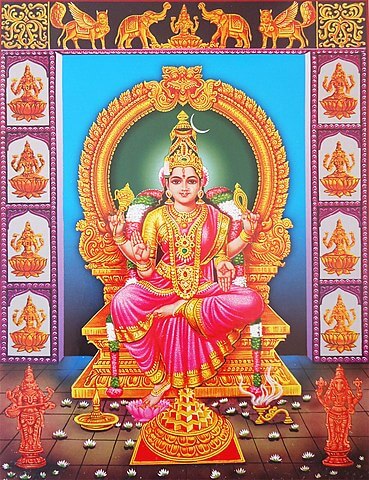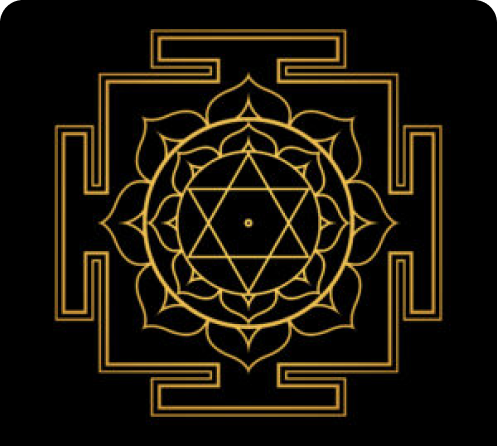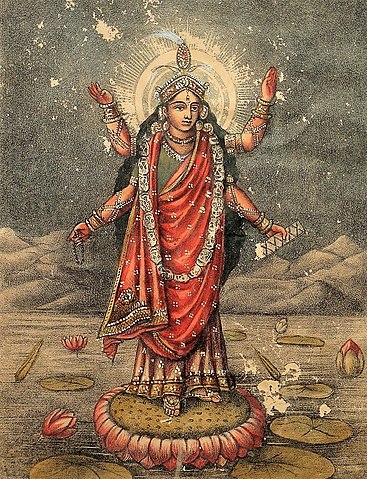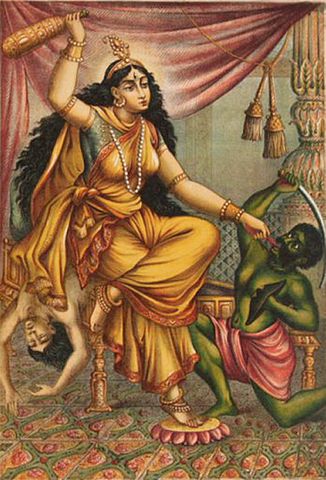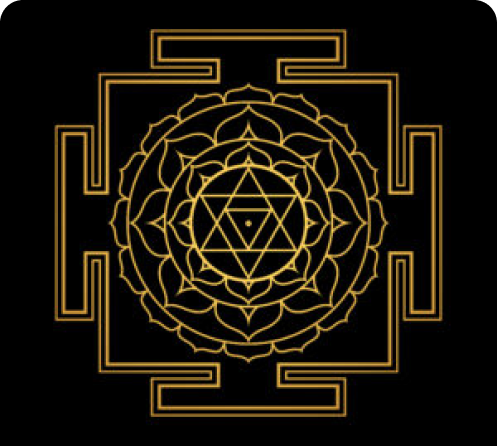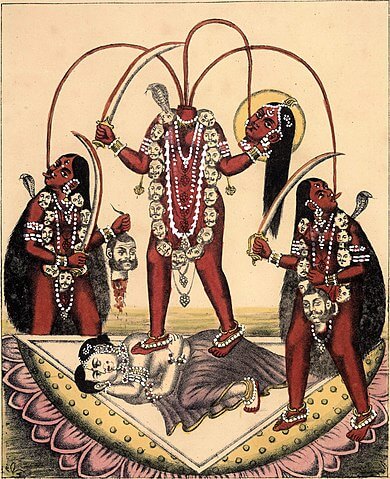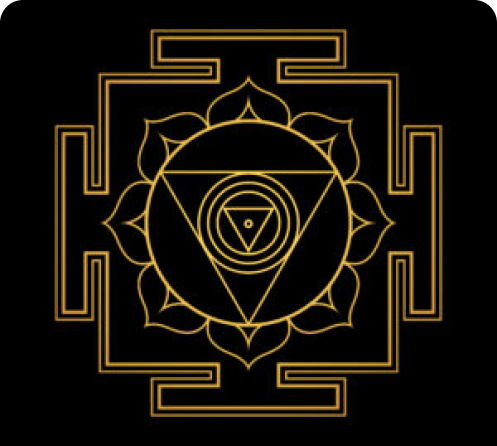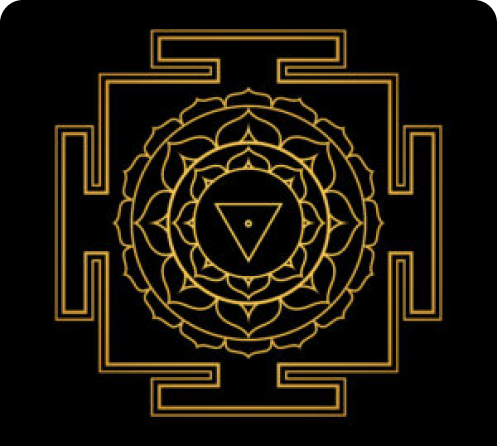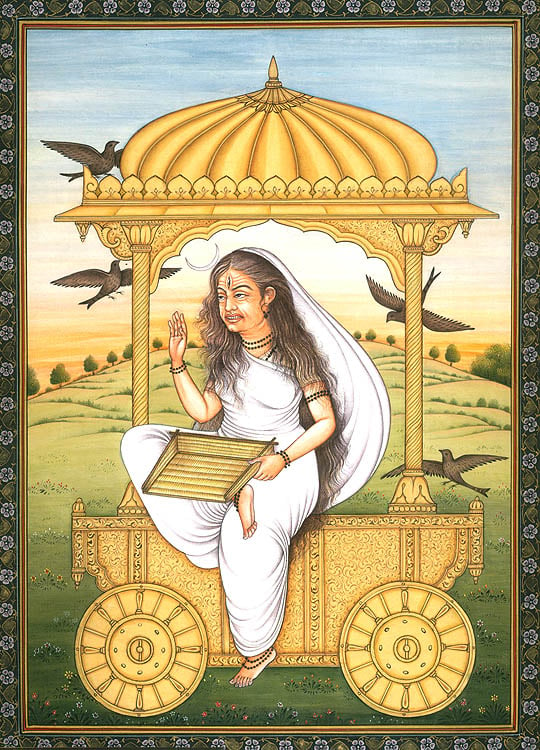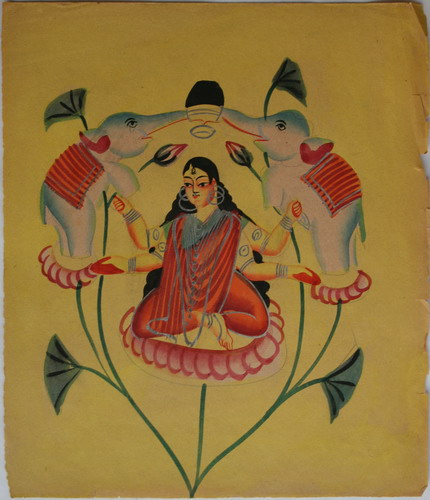Maa Kali Is The First Maa MahaVidya Form Of Maa Maha Kaali And The Dynamic Divine Power Of The Ultimate Reality. Maa Kali Is The Devourer Of kaal (time). As The Divine Mother Of time, death, and destruction, Maa Kali Imparts The Great Cosmic Wisdom Related to transformation. Maa Kali Teaches deserving devotees How To transform the ego-based self by detaching from all things transient and worldly.
The earliest mentions of the worship Of Maa Maha Kaali dates back to pre-vedic times where The Divine Fierce Form Of Maa Maha Kaali was worshipped As The Destroyer Of evil And The Protector Of the righteous
The earliest mentions of the worship Of Maa Maha Kaali can be traced back to the pre-vedic times, approximately around 600 C.E. During this time, Maa Maha Kaali Was Often Associated With warfare and battles. References To Maa Maha Kaali are found in the atharva veda, where Maa Maha Kaali Is Associated With The Darker Aspects Of life, such as death and destruction. However, even in these early mentions,
Maa Maha Kaali Is Revered As A Protective Force. The Depiction Of Maa Maha Kaali’s Fierce Form Symbolizes the destruction of evil and the protection of the righteous.
The Divine Mother Of the universe Protects devotees in distress
After being usurped by the demons shumbha and nishumbha when the gods prayed To The Divine Mother, The Divine Mother Appears To Destroy the demons
According to one allegory In Chapter 7 Of The Holy Text Of _“The Devi Mahatmya”_, Maa Maha Kaali Emerged On the battlefields of the battle against the demons shumbha and nishumbha.
Long ago, two arrogant asuras, shumbha and nishumbha, usurped lord indra’s dominion over the three worlds, causing the gods to lose their power. As The Divine Mother Of the universe Promised To Arrive To Protect Whenever invoked during times of distress, the gods praised and invoked The Divine Mother For Protection.
The Divine Mother Manifested Herself In A Magnificent Divine Form And Made the himalayas Her Place Of Dwelling. The Divine Mother’s Unparalleled Beauty Attracted the attention of chanda and munda, the two servants of shumbha and nishumbha. They concluded that since their masters had already stolen everything valuable from the gods, they should possess “This Most Beautiful Devi” as well.
When the battle began, the demons chanda and munda were sent to fight and retrieve The Divine Mother. As The Divine Mother Observed them and their vast army approaching, She Scowled, And From Her Furrowed Brow, The Fierce Divine Form Of Maa Maha Kaali Emerged And Annihilated the demon forces.
Maa Maha Kaali Emerges To Slay the demons chanda and munda And Is Revered As “Maa Chamunda”
This battle symbolizes the subduing and humbling of the exaggerated ego and intense desires, and overcoming false self-importance and delusions.
“The Devi Mahatmya” in Chapter 7 describes the allegorical battle where The Divine Mother Of the universe Emerges In Her Fierce And Formidable Form As Maa Maha Kaali, Slays the asuras chanda and munda, And Is Revered As
Maa Chamunda.
“‘Because You Have Overpowered chanda and munda And Delivered them To Me, You, O Devi, Shall Henceforth Be Known In the world As Maa Chamunda.’”
– Chapter 7, Verse 27 Of The Devi Mahatmya
chanda and munda, the servants of the asura brothers shumbha and nishumbha who had dispossessed the gods, seizing sovereignty over the three worlds, symbolize those deformities of the ego that exaggerate our ego’s sense of importance, power, or reputation, leading to a tendency to boast or make oneself appear greater than they are. They also symbolize the arousing or provoking intense desire that stimulate or evoke lustful feelings. In these asuras we recognize our ego’s sense of false self, and the delusions and desires attached to it. By The Blessings Of Maa Chamunda, the deserving devotees Are Guided to attain the strength to subdue and humble the ego by overcoming these aspects of it.
In the battle against the demons shumbha and nishumbha, Maa Maha Kaali As Maa Chamunda Destroys the demon raktabija, Symbolizing the destruction of the incessant desires of the ego driven mind
Later in the battle, Maa Maha Kaali As Maa Chamunda Also Destroyed the demon raktabija. The description Of The Destruction Of raktabija is provided in Chapter 8 Of “The Devi Mahatmya”.
Maa Chamunda Slays the demon raktabija By Drinking all his blood. raktabija was the demon whose blood had replicative ability, symbolizing the almost unstoppable power of desire that stems from the ego. Such desire never remains satisfied, and the more it is served, the more it grows.
The Depiction Of Maa Chamunda Lapping Up the flow of raktabija’s blood, Symbolizes that desire is best dealt with before it gets out of hand. Here Maa Chamunda’s Destructive Power Manifests As A Protective Force, Which By Ceasing chitta-vrittis, Enables the realization Of The True Self. Maa Chamunda Grants Her deserving devotees the passage from the relative To The Absolute.
Maa Maha Kaali The Supreme Divine Mother Of the universe is recognised With Many Divine Forms worshipped by devotees And Many Holy “Names” Through Which the devotees praise The Divine Mother Maa Maha Kaali
It is important to understand that Maa Maha Kaali Is Not Merely An Emanation Of The Divine Mother, Maa Maha Kaali Is The Supreme Divine Mother Herself With Many Divine Forms.
Maa Maha Kaali Is One, The Formless Absolute Divine Mother Of the universe worshipped by devotees In Many Divine Forms.
As The Ten Transcendental Forms Of The Divine Mother Maa Maha Kaali, The Maa Das MahaVidya Signify The Ten Supreme Cosmic Wisdom That Guide deserving devotees towards the ultimate goal of one’s spiritual life.
The Maa Das MahaVidya Are:
Maa Kali, Maa Tara, Maa TripuraSundari (Maa Shodashi), Mata Bhuvaneshwari, Maa Bhairavi, Maa BagalaMukhi,
Maa ChinnaMasta, Maa Matangi, Mata DhumaVati, Maa Kamala.
The Divine Mother Maa Maha Kaali Blesses the deserving devotees With spiritual advancement through the learning and internalization Of The Supreme Cosmic Wisdom Teachings Imparted By Maa Das MahaVidya.
Maa Kali As The First Maa MahaVidya Form
Maa Maha Kaali From The Ten Cosmic Wisdom Forms recognised As “Das Maa MahaVidya” by tantrics, yogis and many communities
Maa Kali Is The First Maa MahaVidya Or The Great Cosmic Wisdom Expression Of Maa Maha Kaali.
Maa Kali Blesses Her sincere devotees With Self-Relization By Separating them from ego And Detaching them from the layers of samsara, so that they can find The Divine Truth and see The Divine Light.
Maa Kali As The Divine Mother Of time (kaal) And The Divine Destroyer Of the material world, Imparts Wisdom Regarding the cyclical nature of existence and the transcendence of worldly illusions.
In tantric practices, seeking The Blessings Of Maa Kali marks the starting point for sadhakas (spiritual practitioners) as they delve into The Deeper Mysteries Of The Great Cosmic Wisdom Imparted By The Maa Das MahaVidyas. The sincere worship Of Maa Kali Provides a means to confront and overcome one’s deepest fears, ignorance, and worldly attachments stemming from the ego. By meditating On Maa Kali, tantrics and sadhakas seek to attain liberation (moksha) and a profound understanding Of The Cosmic Play Of Creation And Destruction.
Symbolism In The Depiction Of Maa Kali Impart Profound Wisdom About how to vanquish the ego Upon deserving devotees who worship The Divine Mother With utmost sincerity
Mantra for the worship Of Maa Maha Kaali:
“Om Krim Maa KaliKaye Namah”
Devotees chant this mantra for the worship Of Maa Maha Kaali to seek Her Protection And The Blessings Of transformation.
The Symbolism Of The Depiction Of Maa Kali As A Divine Form Of Maa Maha Kaali Conveys Profound Wisdom. The Black Or Dark Blue Complexion That Maa Kali Is Depicted In Signifies The Infinite Void And The Primordial Darkness From Which all creation arises And Into Which it eventually dissolves. The skull Maa Kali Is Depicted Holding Symbolizes the vanquished ego, And Maa Kali’s Protruding Red Tongue Symbolizes the destruction of the incessant desires of the ego.
Despite The Fearsome Depiction Of Maa Kali, The Divine Mother Is Revered As Deeply Compassionate. Maa Kali Is The Divine Mother Who Fiercely Protects Her Children, Destroying anything that threatens their spiritual progress. Devotees approach Maa Kali with utmost devotion, awe, and Reverence, seeking Blessings For strength, protection, and liberation.
Maa Maha Kaali Is Depicted With Her Lovely Red Protruding Tongue, Imparting The Wisdom That The Divine Mother Can Set whom She Wills free from chronic incessant desires of the ego
As per Myth described in “The Devi Mahatmya”, The Divine Mother Maa Maha Kaali Slays the demon raktabija. Raktabija was the demon whose each drop of blood produced another demon, symbolizing the incessant desires stemming from the ego that keep us bound to the samsara. These desires are never satisfied for long. The more they are fulfilled, the more they increase. Maa Maha Kaali Devoured all the drops of raktabija’s blood and thereafter Killed the demon raktabija, Liberating his soul from the body.
Thus, Maa Maha Kaali Is Depicted With Her Lovely Red Protruding Tongue, Imparting The Wisdom That The Divine Mother Can Set whom She Wills free from chronic incessant desires of the ego.
Conclusion
Emerging As The First Maa MahaVidya Form Of Maa Maha Kaali, Maa Kali Embodies Divine Fierceness And Compassion, Guiding And Enabling deserving devotees to seek and realize The Truth Of Creation, Preservation, And Destruction. The sincere worship Of Maa Kali Enables seekers to transform their lives by receiving Blessings and detaching from all that is transitory and realizing The Eternal And The Absolute.
As A Maa MahaVidya Form Of Maa Maha Kaali, Maa Tara Embodies The Fierce, Protectiveness , And Compassion, Guiding deserving devotees towards spiritual liberation
As A Maa MahaVidya Form Of Maa Maha Kaali, Maa Tara Embodies Fierceness, Protectiveness, And Compassion.
Maa Tara Fiercely Protects Her devotees from the darkness of ignorance and the delusions of ego.
Maa Tara’s Compassion Is Boundless, Guiding deserving devotees to navigate through life’s tumultuous challenges and cutting through obstacles By Her Divine Blessings. By embracing the sincere worship Of Maa Tara, devotees may be able to embark on a transformative journey towards spiritual liberation, where they can transcend worldly attachments and realize The True Self.
Origin Myth About The Emergence Of Maa Tara As
Maa MahaVidya, Embodying Fierceness And Imparting The Wisdom Of Transformation Upon deserving devotees
The worship Of Maa Tara has roots that are at least as ancient as the vedas. A Myth that originates from various puranas such as The “Devi Bhagavata Purana”, The “Kalika Purana”, and various tantras dedicated to the worship Of
Maa Das MahaVidyas, narrate the story Of The Divine Mother As Maa Sati And Her Transformation Into
Maa Das MahaVidyas, First As Maa Kali And Later As Maa Tara.
As per The Origin Myth, when lord shiva forbade Maa Sati From Attending Her father’s sacred yajna (ritual offering),
Maa Sati Grew Furious And Transformed Into The Formidable And Fierce Form Of Maa Kali. This Sudden Transformation caused lord shiva to flee in a different direction. Subsequently, Maa Sati Emerged In The Divine Form Of Maa Tara.
Maa Tara Is Depicted In A Blue Complexion, With Her Protruding Red Tongue And A Face That Instills fear.
Maa Tara Is Depicted With Disheveled Hair, Resembling upright snakes. Maa Tara Is Adorned With a tiger’s skin, The Divine Forehead With Five Crescent Moons, And With Three Eyes And Four Divine Arms. Maa Tara Stands Upon a corpse And Carries A Lotus, A Sword, A Drinking Bowl, And A Bell In Her Divine Hands. The Divine Mother As Maa Tara Embodies Fierceness, Imparting The Wisdom Of Transformation Upon deserving devotees. Devotees worship Maa Tara with utmost sincerity, seeking Her Blessings for spiritual enlightenment.
The Legend recounted in todala tantra that signifies The Maternal Compassion Of The Divine Mother Maa Tara
According to the Legend recounted in the todala tantra, when the gods and the asuras (demons) jointly churned the milky ocean in search of the immortal nectar, instead of the nectar, a lethal poison called “halahala” emerged, causing great agitation. All were agitated except for the mighty lord shiva, who remained calm and composed. In order to save the world, lord shiva fearlessly consumed the poison, thereby preventing its destructive effects. However, the intensity of the poison rendered him unconscious.
At this critical moment, The Divine Mother Manifested As Maa Tara And Cradled lord shiva In Her Lap. Maa Tara Nursed him, Which Acted As An Antidote To the poison, Reviving lord shiva. This Myth bears resemblance to another Tale in which lord shiva pacifies The Furious
Maa Maha Kaali by taking the form of an infant. Upon Seeing the child,
Maa Maha Kaali’s Maternal Instincts Arise, And She Becomes Tranquil, Nursing the infant lord shiva. In both narratives, lord shiva takes a vulnerable position as an infant In The Presence Of The Divine Mother Of the universe.
The Divine Mother Maa Tara As The Compassionate Savior And Fierce Protector Is worshipped with greatest sincerity across cultures and traditions.
Maa Tara Is Revered across cultures. In sanatana and buddhists traditions, Maa Tara Is worshipped seeking Guidance to face and overcome life’s challenges. However, The Depiction Of Maa Tara Varies Greatly across traditions. As A
Maa MahaVidya Form Of Maa Maha Kaali, Maa Tara Is Depicted As Fierce And Formidable. In other traditions, such as the tibetan buddhism, Maa Tara Is Depicted As The Compassionate And Protective Divine Mother.
The history of the worship Of Maa Tara in tibetan buddhism
In tibetan buddhism, Maa Tara Is Highly Venerated And worshipped As A national Deity. In this tradition, Maa Tara Is Depicted To Embody Compassion And Protects Her devotees from harm. As per Origin Myth in tibetan buddhism,
Maa Tara Is Associated With avalokitesvara, the bodhisattva of compassion. One Legend states that Maa Tara Emerged From a tear shed by avalokitesvara out of pity for all suffering beings. This Legend Signifies Maa Tara As A Compassionate Savior Of Her devotees.
The significance of the worship Of Maa Tara in tibetan buddhism grew substantially around the 11th century, largely due to the efforts of the scholar atisa, who had numerous Visions Of Maa Tara and translated key texts About Maa Tara into tibetan. These texts highlight Maa Tara’s Blessings Of protection and prolonged life Upon deserving devotees. Devotees also seek Maa Tara’s Blessings For Miraculous Rescues In dire situations, such as execution, imprisonment, or natural disasters.
Maa Tara Is Also worshipped In Fierce Forms In buddhism, such as In The Form Of “Maa Tara Kurukulla”, Who Is invoked To Subdue And Destroy evil forces. The worship Of Maa Tara In Her Fierce Forms show that devotees Revered Maa Tara As The Compassionate Yet Fierce Protector.
Maa Tara Is Revered In Eight Divine Forms Signifying The Divine Mother’s Fierceness And Compassion
In ancient indian texts, Maa Tara Is Associated With destruction, And Is Often Depicted Dwelling In cremation grounds, With skulls, severed heads, and blood around. This iconography Of The Depiction Of Maa Tara Signifies Her As The Fearsome Divine Mother. However, Maa Tara Is Also Depicted With Round Belly And Full Breasts To Signify Her Nurturing And Maternal Compassion. Maa Tara Is Also Revered As The Divine Savior Who Guides deserving devotees to cross the ocean of samsara, transcend the cycle of rebirth, and attain spiritual liberation.
Maa Tara Is Revered In Eight Divine Forms Signifying Her As The Fierce and Compassionate Divine Mother. The Eight Divine Forms Of Maa Tara Are mentioned in the “Māyātantra”, as cited in the tantric collection tantrasāra. The Eight Divine Forms Are:
Maa Mahogra,
Maa UgraTara,
Maa Kameswari Tara,
Maa Neela Swaraswati,
Maa Ekajata,
Maa Chamunda,
Maa BhadraKaali,
Maa VajraTara
Maa Tara worshipped In Her Eight Divine Forms Blesses deserving devotees With Protection And Guidance to overcome ignorance and achieve spiritual growth.
The “Maa TaraPith Temple” for the worship Of Maa Tara, Is A Revered “Shakti Pith” And Is Known for tantric rituals and practices for the worship Of Maa Tara
The “Maa TaraPith Temple” is dedicated to the worship Of Maa Tara. According to legends, The “Maa TaraPith Temple” Is A “Shakti Pith” In Reverence Of Maa Sati’s Divine Eyeball. “Shakti Piths”, Divine Seats Of The Divine Mother
Maa Aadi ParaShakti, Are Revered As The Holy Sites On earth Where The Various Divine Parts Of Maa Sati’s Holy Body are said to Have Fallen during lord shiva’s rudra tandava in grief Of Maa Sati’s Self-Immolation. As the bengali word for eyeball is tara, the temple was dedicated to the worship Of Maa Tara. The “Maa TaraPith Temple” is also renowned for being one of the few temples where tantric rituals are practiced. The adjacent cremation ground At The “Maa TaraPith Temple” is an important site for tantric practices and sadhana (spiritual practice). It is believed that the cremation ground is a favored place for worshipping Maa Tara, The Divine Mother Of death and transformation.
The history of worship Of Maa Tara At The “Maa TaraPith Temple”
The worship Of Maa Tara At The “Maa TaraPith Temple” can be traced back to vashishta’s quest to master the tantric arts. Despite his prolonged efforts, he failed to achieve success. Seeking guidance, he approached buddha, who had a vision that The “Maa TaraPith Temple” was the ideal place to worship Maa Tara. Following buddha’s advice, vashishtha came to The “Maa TaraPith Temple” and performed a left-handed tantric ritual, incorporating the use of the 5 forbidden elements (panchamakara). Accepting his devotion, The Divine Mother Manifested As Maa Tara Nursing lord shiva At Her Breast And Then Transformed Into A Stone. Since then, The Depiction Of Maa Tara In Her Maternal Form, Nursing
lord shiva, Has Been Venerated At The “Maa TaraPith Temple”. This Depiction Of Maa Tara Connects to the Myth Where
Maa Tara revived lord shiva after he consumed poison during the churning of the ocean.
The Two Idols for the worship Of Maa Tara At The “Maa TaraPith Temple”
Inside the sanctum, There Are Two Idols for the worship Of Maa Tara. The First Is A Stone Image Portraying Maa Tara As A Mother Nursing lord shiva, but It Is Concealed By A Three-Foot-Tall Metal Image That Is Typically Visible To the worshippers. The Stone Statue Depicts Maa Tara In Her Fierce Form, With Four Arms, Flowing Hair, An Extended Tongue, And Adorned With A Garland Of skulls. The Outer Metal Image Is Adorned With a silk sari, marigold garlands, and sheltered by a silver umbrella Above.
Only after the evening aarti ceremony do the devotees have the opportunity to catch a glimpse Of The Original Stone Idol.
Conclusion
Maa Tara, As A Maa MahaVidya Form Of Maa Maha Kaali, Embodies Fierce Protectiveness And Boundless Compassion. Maa Tara Guides deserving devotees through life’s challenges, Leading them towards spiritual liberation. The Ancient Myths Surrounding Maa Tara Signify Maa Tara As The Compassionate Savior And Fierce Protector, Emanating In Many Divine Forms Across cultures and traditions. Innumerable devotees across time and traditions worship Maa Tara, seeking Blessings to transcend the worldly ocean and attain spiritual liberation.
Maa Tripura Sundari, Also Revered As Maa Shodashi, Is The Third Maa MahaVidya Form Of Maa Maha Kaali.
Maa Maha Kaali As Maa Tripura Sundari (Maa Shodashi) Embodies The Beauty That Is Seen In the world externally And The Inner Beauty Which Resonates Deep Within an aware mind. Maa Tripura Sundari (Maa Shodashi) Imparts Wisdom Of unity and oneness in all existence. Maa Tripura Sundari (Maa Shodashi) Guides deserving devotees to purify their minds by clearing away negative thoughts and showing them beauty in everything.
By meditating On The Transcendent Beauty Of Maa Tripura Sundari (Maa Shodashi), devotees can find joy and compassion both outwardly and inwardly, gradually leading them to a deep awareness of the oneness of all existence.
Maa Tripura Sundari, The Divine Mother Of Transcendent Beauty, Imparts Wisdom That Leads deserving devotees to a complete understanding of reality and the state of enlightened consciousness
As A Maa MahaVidya Form Of The Primordial Divine Mother Of the universe, Maa Tripura Sundari Is Also Recognised And Worshipped As Maa Sodashi, Maa Lalita Devi, Maa Kamesvari, Maa SriVidya, And Maa RajaRajesvari.
Maa Tripura Sundari Guides deserving devotees towards a complete understanding of reality and the state of enlightened consciousness.
Maa Tripura Sundari Is Depicted As A Radiant Form Of The Divine Mother With The Light Of The Rising Sun, Holding A Noose, A Goad, Arrows, And A Bow In Her Four Divine Hands. Maa Tripura Sundari Is Also Depicted Seated On A Lotus That Emerges From lord shiva’s navel, Signifying Maa Tripura Sundari’s As Self-Emergent.
The Depiction Of Maa Tripura Sundari Is mentioned in detail in sacred texts such as The “Sri Maa Lalita-Sahasranama”, Describing The Depiction Of Maa Tripura Sundari Seated On A Throne Adorned With Jewels (And Auspicious Marks of a married woman). In The Depiction, Maa Tripura Sundari Is Attended By the gods lord brahma, lord vishnu, and lord Shiva. Maa Lakshmi, And Maa Sarasvati Are Also Present In The Depiction.
The history of the worship Of Maa Tripura Sundari
The worship Of Maa Tripura Sundari have deep roots in both kashmiri and south indian tantrism, particularly within The “SriVidya”, which is a tantric religious system devoted to the worship Of The Divine Mother. “SriVidya” developed out of various influences, especially kashmir shaivism, and its doctrines remain similar to this tradition. The “SriVidya” tradition emphasizes private, tantric worship centered on mantra for the worship Of Maa Tripura Sundari, Known As
“SriVidya Mantra” and The Sacred Yantra for the worship Of Maa Tripura Sundari Known As “Sri Chakra”.
The earliest references to “SriVidya” can be found in the tamil work tirumantiram by tirumular (7th century CE). By the 9th century, the worship Of Maa Tripura Sundari spread, with significant texts attributed to the philosopher sankara. Over time, the worship Of Maa Tripura Sundari expanded throughout india, including bengal, and continues to be significant today.
Maa Tripura Sundari Destroyed the demon bhanda To Protect the gods and restore cosmic stability
As per Myth, Maa Tripura Sundari Defeated the demon bhanda, who was born from lord shiva’s rage. The Tale begins with lord shiva destroying lord kama, the god of love, when lord kama tries to distract lord shiva during meditation. One of lord shiva’s followers then makes a man from lord kama’s ashes. This man made from the ashes asks lord shiva for a powerful mantra, which lord shiva gives him. This mantra gives the man made from ashes half the strength of his enemies. Lord shiva also makes the man ruler of the world for sixty thousand years and praises him with the words “bhand! bhand!” (“good! good!”). Thus named bhanda, this man now becomes a dangerous demon and builds a city to rival the gods’ city. When bhanda attacks lord indra, lord indra asks the sage narada for help, who then tells him to pray to Maa Tripura Sundari.
Lord indra and his allies perform vedic rites, in worship Of Maa Tripura Sundari. Maa Tripuara Sundari Arrives To Bring An End To bhanda’s rule. To Prepare For battle, Maa Tripura Sundari Creates An Army Of powerful warriors And Many Divine Weapons From Her Noose And Goad. The ignorant demon bhanda mocks the Divine Weapons, ignorantly thinking they will be weak, and is soon destroyed By The Divine Mother Maa Tripura Sundari.
After the battle, the gods, led by lord kama’s wife, rati, pleads with Maa Tripura Sundari to bring lord kama back to life. To restore desire in the world, Maa Tripura Sundari accepts their prayers and brings lord kama back to life. This Myth Signifies Maa Tripura Sundari As The Protector Of the gods and cosmic stability, Overseeing cosmic processes.
The Divine Forms And The Holy “Names” Through Which devotees praise and worship The Divine Mother
Maa Tripura Sundari
As per Myth in The “Sri Maa Lalita-Sahasranama”, In the battle against demon bhanda, Maa Tripura Sundari Created the ten forms or avatars of lord vishnu From Her Ten Divine Fingernails to fight against bhanda’s army. As The Valiant Destroyer Of bhanda And The Protector of all gods, Maa Tripura Sundari Is Revered As The Divine Mother Who Rules Divine Armies, Slays demons, And Grants Boons to warriors.
As The Divine Mother Who Grants Boons to warriors, Maa Tripura Sundari Is worshipped by warriors, and mothers of warriors. Maa Tripura Sundari Is Also worshipped by kings, And So Is Venerated As Maa RajaRajesvari, The Divine Mother Who Is Queen Of kings.
The Many Holy “Names” Through Which devotees praise and worship Maa Tripura Sundari Hold Deep Significance, Reflecting The Divine Mother’s Cosmic Wisdom Teachings. The Holy “Name” “Maa Tripura Sundari” “Means”
“The Divine Mother Who Is The Source Of all beauty in the three worlds”, Symbolizing various triads in ancient indian philosophy. These triads include creation, maintenance, and destruction, and the relationship between subject, instrument, and object. “Tripura” is also said to symbolize the three states of consciousness, which are identified by the yogis as jagrat (waking), swapna (dreaming), and shushupti (sleeping).
The Holy “Name” “Maa Shodashi” “Meaning” “The Divine Mother Who Is Sixteen,” Signifies That The Divine Mother Is Beyond the constructs of time and age.
By praising The Divine Mother As “Maa Lalita” devotees meditate On The Divine Grace And Beauty Of The Divine Mother.
Conclusion
Maa Tripura Sundari As The Divine Mother Of Transcendent Beauty And The Protector Of Cosmic Stability,
Maa Tripura Sundari Imparts Wisdom About the unity and interconnectedness of all existence Upon deserving devotees, Guiding them to purify their minds, embrace inner beauty, and achieve a higher state of consciousness.
Mata Bhuvaneshwari Is The Fourth Maa MahaVidya Form Of Maa Maha Kaali. Mata Bhuvaneswari Is Revered As The Divine Mother And Empress Of the universe.
Mata Bhuvaneshwari Also Known As Maa BhuDevi Is The Supreme Empress Of manifested existence, The Ruler Of the entire cosmos, the bhuvanatraya, consisting of the heavens, the atmosphere, and the earth, And The Source Of all creation.
Mata Bhuvaneshwari As Maa MAHAMAYA, Appears As This Illusory World. Mata Bhuvaneshwari As Maa SarvaRupa, Is All-Pervasive. Mata Bhuvaneshwari Is Maa VisvaRupa, Whose Form Is The Universe. Mata Bhuvaneshwari Is
Maa Vagisvari, Who Rules Over The Process Of Cosmic Manifestation.
All That humans experience in this life and this world Is The Manifestation Of The Divine Mother Mata Bhuvaneshwari.
As the Gracious Nurturing Divine Mother Mata Bhuvaneshwari Sustains all that She Has Given Birth To. By The Blessings Of Mata Bhuvaneshwari deserving devotees are Enabled to overcome any hindrances that conceal the realization Of The True Self.
The Depiction Of Mata Bhuvaneshwari Imparts Divine Wisdom Upon deserving devotees
Mata Bhuvaneshwari Is Depicted With A Vermillion Complexion, Reminiscent Of the rising sun, Symbolizing the dawn of wisdom and enlightenment, A Gentle, Compassionate Expression, Reflecting The Divine Mother’s Benevolence, And A Crown Adorned With Jewels And A Crescent Moon, Symbolizing the cosmic rhythms and time cycles. In Her Four Divine Arms, Mata Bhuvaneshwari Is Depicted Holding A Red Lotus, A Bowl Filled With Jewels, A Pasha (Noose) Symbolizing control over the cycle of birth and death, And An Ankusha (Goad) Symbolizing the power to remove obstacles.
Mata Bhuvaneshwari’s Divine Right Foot Rests On A Jeweled Jar. Mata Bhuvaneshwari Is Also Often Depicted Seated On A Lotus, Symbolizing purity and spiritual awakening.
Mata Bhuvaneshwari’s Wisdom Teachings Guide deserving devotees to recognize The OmniPresence Of The Divine Mother Throughout all existence, Enabling them to transcend individual identity and unite with the oneness of existence
Mata Bhuvaneshwari Is The Source Of the manifest universe, Embodying The Fundamental Elements—Ether, Fire, Water, Wind, And Earth—And All Of The Physical And Cosmic Worlds. Mata Bhuvaneshwari Is The Divine Mother Of The Space Within Which creation unfolds. The Wisdom Teaching Of Mata Bhuvaneshwari Guides deserving devotees to realize The OmniPresence Of The Divine Mother In All Of existence, and transcend individual identity and merge with the oneness of existence.
A hymn in the rudrayamala praises Mata Bhuvaneshwari As The Mother Of lord brahma, lord vishnu, and lord shiva, who are responsible for creation, maintenance, and destruction. Mata Bhuvaneshwari Is Also Revered As The Cause Of MahaPralaya (The Great Cosmic Dissolution). In the prapancasara-tantra, lord shiva praises Mata Bhuvaneshwari As The Divine Mother Of all that is knowable, And In Whom the world rests during MahaPralaya.
The Divine Mother As Mata Bhuvaneshwari Pervades the worlds, Governing The Three Cosmic Functions Of Creation, Maintenance, And Destruction
As per Myth, in the beginning, when the sun god surya appeared in the heavens, sages offered The Holy Plant Soma, to help create the world. By The Blessings Of The Divine Mother As Maa Tripura Sundari (Maa Shodashi), surya dev then created the three worlds. After the creation of the three worlds, The Divine Mother As Mata Bhuvaneshwari Pervades the worlds, Governing The Three Cosmic Functions Of Creation, Maintenance, And Destruction. Mata Bhuvaneshwari Is The Divine Source From Which all existence emerges And Into Which it eventually dissolves.
The sincere worship Of Mata Bhuvaneshwari can enable deserving devotees to expand consciousness and foster a deep sense of unity with the universe
The Bija Mantra “Hrim” is central to the worship Of Mata Bhuvaneshwari, Encapsulating The Divine Essence Of
Mata Bhuvaneshwari. In tantric philosophy, This Sacred Mantra Signifies Creation And The Stages In The Creative Process.
The worship Of Mata Bhuvaneshwari involves various rituals, prayers, and meditative practices to seek Blessings Of The Divine Mother. The sincere worship Of Mata Bhuvaneshwari can enable deserving devotees to expand consciousness and foster a deep sense of unity with the universe.
The Wisdom Teachings Of Mata Bhuvaneshwari Guides deserving devotees to realize the interconnectedness of all life forms, encouraging compassion for the world, and the importance of care, empathy, and support in building a harmonious global community.
Conclusion
Mata Bhuvaneshwari As The Divine Empress Of the universe Is The Source And Sustainer Of the physical and cosmic worlds. As The Supreme Embodiment Of manifested existence, Mata Bhuvaneshwari Teaches How To reach beyond the limitations of human existence and gain realization Of The True Self.
The Gracious Nurturing Divine Mother Mata Bhuvaneshwari Sustains all that She Has Created. Everything in existence that humans experience, Is The Manifestation Of The Divine Mother Mata Bhuvaneshwari. Seekers worship
Mata Bhuvaneshwari, seeking Guidance to attain realization Of Absolute Reality by reaching beyond the limitations of the human body, mind, personality, and life.
The Formidable, Glorious Divine Mother Maa Bhairavi, Shining With The Effulgence Of Ten Thousand Blazing Suns, Blesses With the ability to attain the state that is beyond the fear of death, which, in vedanta, is referred to as the
‘state-of-brahman’. Maa Bhairavi, Is Revered In The Highest Place In tantric traditions and the sincere worship Of Maa Bhairavi can enable seekers to overcome obstacles on their spiritual journey. As The Fierce Yet Compassionate Divine Mother, Maa Bhairavi Protects Her children from harm And Guides Her devotees towards spiritual growth and enlightenment.
In Her Fierce Form Maa Bhairavi Is The Divine Mother Of destruction, Yet Maa Bhairavi Also Grants Blessings, Protection, And spiritual knowledge to deserving devotees
Maa Bhairavi Is worshipped by devotees In Many Divine Forms And Is Depicted Embodying The Many Divine Powers And Wisdom Teachings.
In One Revered Form, Maa Bhairavi Is Depicted With A Glowing Complexion, Like The Light Of Many Blazing Suns, Wearing Red Silk Clothes And A Garland of severed human heads. Maa Bhairavi Is Depicted With Four Divine Arms, Holding A Rosary And A Book In Two Of Them, While The Other Two Hands Make Gestures That Grant wishes And Dispel fear. Maa Bhairavi’s Divine Face Is Adorned With Three Lotus-Like Eyes, A Half-Moon On Her Divine Forehead, And A Jeweled Crown On Her Divine Head.
In Her More Formidable And Fearsome Form, Maa Bhairavi Is Depicted Residing In cremation grounds, Seated On a headless corpse. The Depiction Of Maa Bhairavi Has A Fierce Expression, With Three Eyes That Symbolize the ability to see past, present, and future, Disheveled Hair, A Garland Of skulls or severed human heads, And A Divine Body Smeared With blood, Signifying Maa Bhairavi As The Destroyer Of evil and ignorance. Maa Bhairavi’s Complexion Is Often Depicted As Dark Or Red, Reflecting The Primal Energy Maa Bhairavi Embodies. In The Fierce Divine Form, Maa Bhairavi Is Also Depicted Holding Various Weapons Such As A Trident, Sword, And Noose.
The Depiction Of Maa Bhairavi’s Fierce Form Symbolizes the destructive power of time, which ultimately consumes everything. However, this destruction is not negative; it is a necessary force for the creation of new life and the removal of ignorance and evil. Maa Bhairavi Teaches devotees to confront their fears, embrace change, and transcend the limitations of the material world.
In tantric practices, Maa Bhairavi Is worshipped As The Divine Mother Who Bestows spiritual enlightenment and liberation (moksha/mukti). Devotees invoke Maa Bhairavi during times of crisis or when they seek inner strength and protection. Maa Bhairvai Is Also worshipped seeking Protection against enemies, and to be able to overcome obstacles and difficulties in life.
A hymn in praise And Veneration Of Maa Bhairavi
An early hymn from the sdradd-tilaka, a ninth-century text, describes Maa Bhairavi As The Divine Mother Beyond words, Whom even the gods cannot fully describe. Maa Bhairavi Is worshipped As The Source Of the universe, Primordial And OmniPresent. Maa Bhairavi Is Also Revered As The Source Of speech and consciousness, And The Source of all the vedas, Embodying Knowledge And Wisdom. In the hymn, Maa Bhairavi Is Also described As The Source Of the sun’s power to sustain the world and the fire that dissolves it.
The hymn further describes that Maa Bhairavi Controls vital energies And Grants yogic powers to deserving seekers, Helping them to overcome passions like lust, greed, and anger. Through yoga, Maa Bhairavi Guides deserving devotees to overcome worldly desires. Maa Bhairavi Is worshiped As The Divine Mother Of the kundalini energy that awakens and rises through the body, symbolizing the awakening of consciousness. The hymn also praises The Divine Beauty Of
Maa Bhairavi, With The Power To Evoke passion While Also Controlling it. Maa Bhairavi Is Venerated As The Divine Teacher And Revealer Of knowledge that guides spiritual practice.The Fearsome, Glorious Maa Bhairavi Is Also The Benevolent
Divine Mother, Providing nourishment and fulfilling the auspicious desires of deserving devotees.
As Maa Tripura Bhairavi, Maa Bhairavi Is The Divine Mother Of the three places, which yogis identify with the three states of jagrat (waking), swapna (dreaming), and shushupti (sleeping)
The Divine Mother Maa Bhairavi Is Also worshipped As Maa Tripura Bhairavi. As Maa Tripura Bhairavi Is The Divine Mother Of the three places, which yogis identify with the three states of jagrat (waking), swapna (dreaming), and shushupti (sleeping).
Maa Tripura Bhairavi Is Also Associated With triads or groups of three, Symbolizing different aspects of creation, sustenance, and destruction, the three energies – icchā (will), jñāna (knowledge), and kriyā (action), the three vital energy channels (nādis) in the body: ida, pingala, and sushumna, as well as the three worlds (bhūr, bhuvaḥ, suvaḥ) and the three qualities (gunas) of nature: sattva, rajas, and tamas. Maa Tripura Bhairavi Blesses deserving devotees With Guidance On the journey towards realization Of The Ultimate Reality, that can be achieved by transcending these triads.
Maa Tripura Bhairavi Is Also Worshipped As “Vāk Devi”, The Divine Mother Of speech, And The Source Of all words. Speech in its highest form is linked To The Divine Sound Or Śabda Brahman, Which Is The Primordial Vibration That Brings the universe into existence. As speech evolves, it moves through different stages, from a subtle, unmanifested form to the fully expressed word. This journey mirrors the spiritual path, moving from ignorance to attaining realization.
Maa Tripura Bhairavi Blesses deserving devotees with the transformative power of fire (tejas tattva). The Blessings Of Maa Tripura Sundari Purify And Transform devotees, By Burning away impurities and obstacles that hinder spiritual progress. This fire is both literal and metaphorical, signifying the intense discipline (tapas) and effort required to overcome desires and attachments on the path to spiritual liberation.
Conclusion
Maa Bhairavi Is Revered As The Divine Mother Of destruction And The Ultimate Power Behind the dissolution of the universe. The Fierce Maa Bhairavi Is Also The Compassionate Divine Mother Who Grants Blessings And Boons To deserving devotees.
Worshipped As Maa Tripura Bhairavi, Maa Bhairavi Is The Protective Divine Mother, Shielding devotees From negative influences And Guiding them through the challenges they face on their spiritual journey. As The Divine Mother Of destruction, The Depiction Of Maa Bhairavi’s Fearsome Divine Form Imparts The Wisdom That The Destruction of illusion and ignorance is necessary for attainment of liberation {mukti}.
The Divine Mother Maa Kamala Blesses devotees with spiritual liberation. Maa Kamala Guides the sincere devotees to work for the wellbeing of others and pursue the wealth of righteousness, encompassing qualities such as devotion, kindness, compassion, truthfulness, and various virtues significant on the path towards realizing The True Self.
The Divine Depiction Of Maa Kamala
The Divine Mother Maa Kamala Is Depicted With Golden Complexion, Clothed In Red, And Richly Adorned With Gold Jewelry. Depicted With Four Divine Hands, Maa Kamala Holds Lotus Flowers In Two Hands, And Gestures
The Varada Mudra (Granting Blessings) And Abhaya Mudra (giving protection and removing fear) With The Other Two Hands.
Maa Kamala Is Also Depicted Seated On A Lotus In the middle of an ocean, With Elephants On Either Sides, Pouring Water On Maa Kamala In a ritual called abhishekam.
Abhishekam is a ritual of bathing An Idol Or Image for the worship Of The Divine Mother with water, milk, honey, yogurt, ghee (clarified butter), and sometimes fruit juices or other purifying liquids as an act of worship. The ritual is usually accompanied by the chanting of mantras and prayers. Abhishekam is performed to invoke Blessings Of The Divine Mother, express devotion, and cleanse the devotee’s mind and spirit. It’s a common practice in temples and during special religious ceremonies.
The Symbolism Of The Lotus
The Divine Mother Maa Kamala Is Depicted Seated On A Lotus Seat, Symbolizing purity.
In nature, a lotus blooms in mud but always remains untainted and stainless. In the same way, The Lotus Upon Which Maa Kamala Is Depicted Seated, Teaches the sincere devotees how to harbor purity within by remaining unaffected and detached from anything that can derail them from the path Of Truth.
Most of the time, we think that what derails us is outside, in our external environment. But the truth is, the activities of our ego-driven mind derail us the most. To subdue the ego-driven mind, it is essential to look within and overcome every hidden aspect of the ego, such as arrogance, jealousy, or selfishness, that can make one irreverent.
By The Blessings Of The Divine Mother Maa Kamala, when deserving devotees are Enabled to subdue their ego-driven mind, they can attain inner purity to help progress on the path towards spiritual liberation.
The worship Of Maa Kamala
Worshipped across cultures, primarily in eastern india, particularly in bengal, odisha, and assam, Maa Kamala holds a special place in the hearts of devotees. The worship Of Maa Kamala Guides sincere devotees to transcend the desire and attachment for material wealth, and realize the significance of spiritual abundance and the nurturing of wisdom and compassion.
Rituals and practices of worship
The worship Of Maa Kamala involves a series of rituals, to seek Blessings. The worship begins with the purification of the worship space and the worshippers themselves, emphasizing cleanliness and purity, which are essential aspects of worship. Offerings of flowers, particularly lotus flowers, fruits, sweets, and other items of worship are made.
Devotees often light lamps or diyas during the worship, symbolizing the illumination of knowledge and the dispelling of ignorance. The chanting of mantras for the worship Of Maa Kamala, is a crucial part of the ritual.
Significance of festivals dedicated to the worship Of Maa Kamala
Among many festivals, Maa Kamala Is Venerated during diwali, the festival of lights. During diwali, homes and temples are adorned with lights and decorations to welcome The Divine Mother. In eastern india, the worship Of Maa Kamala,, seeking protection, prosperity, and spiritual liberation, is also connected to The “Maa Kaali Puja”.
Conclusion
The Divine Mother Maa Kamala Is The Bestower Of the wealth of knowledge and wisdom for the realization Of The True Self, Leading to spiritual liberation. By The Blessings Of Maa Kamala, devotees are Enabled to subdue their ego and detach from worldly attachments and pursuits, and are Guided to cultivate inner purity and attain a state of peace and balance within. Blessed With balance within, devotees are Empowered to contribute to and support the spiritual growth and wellbeing of all.




